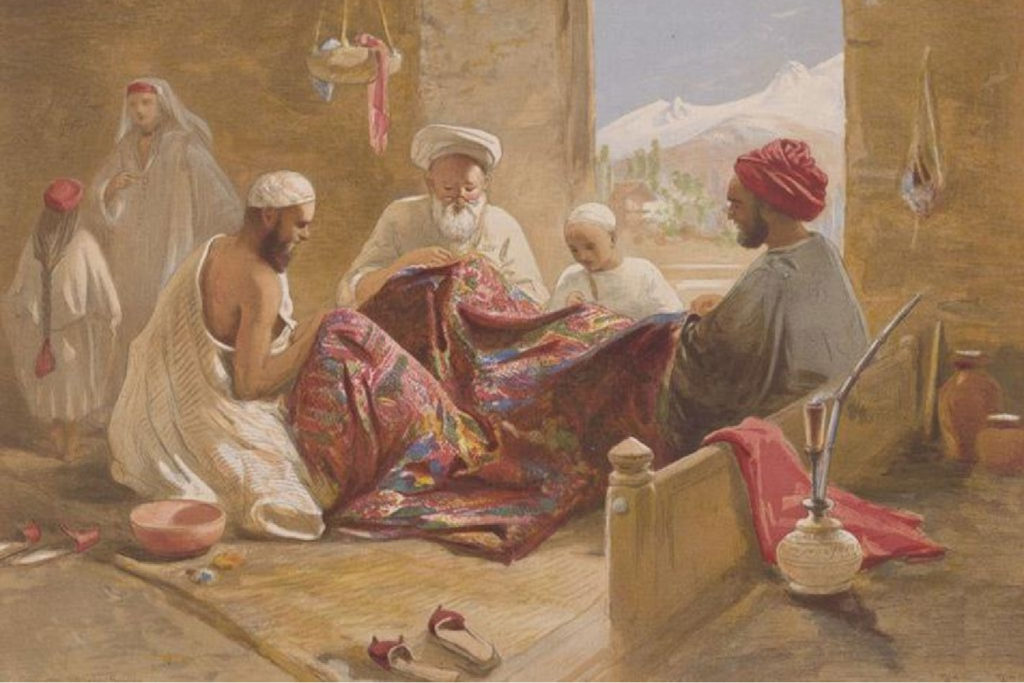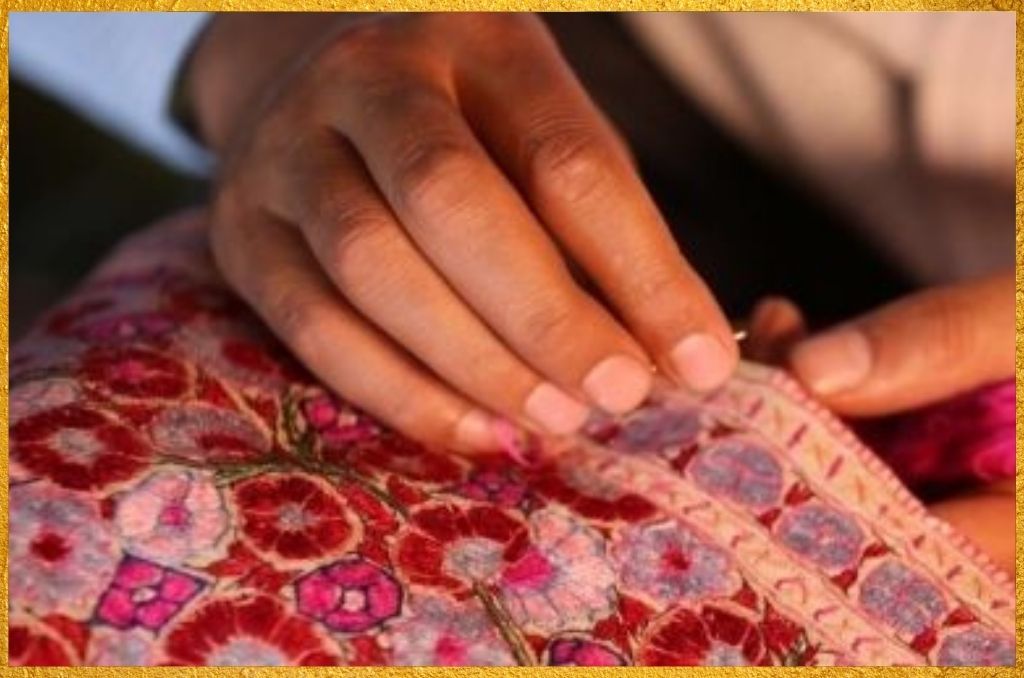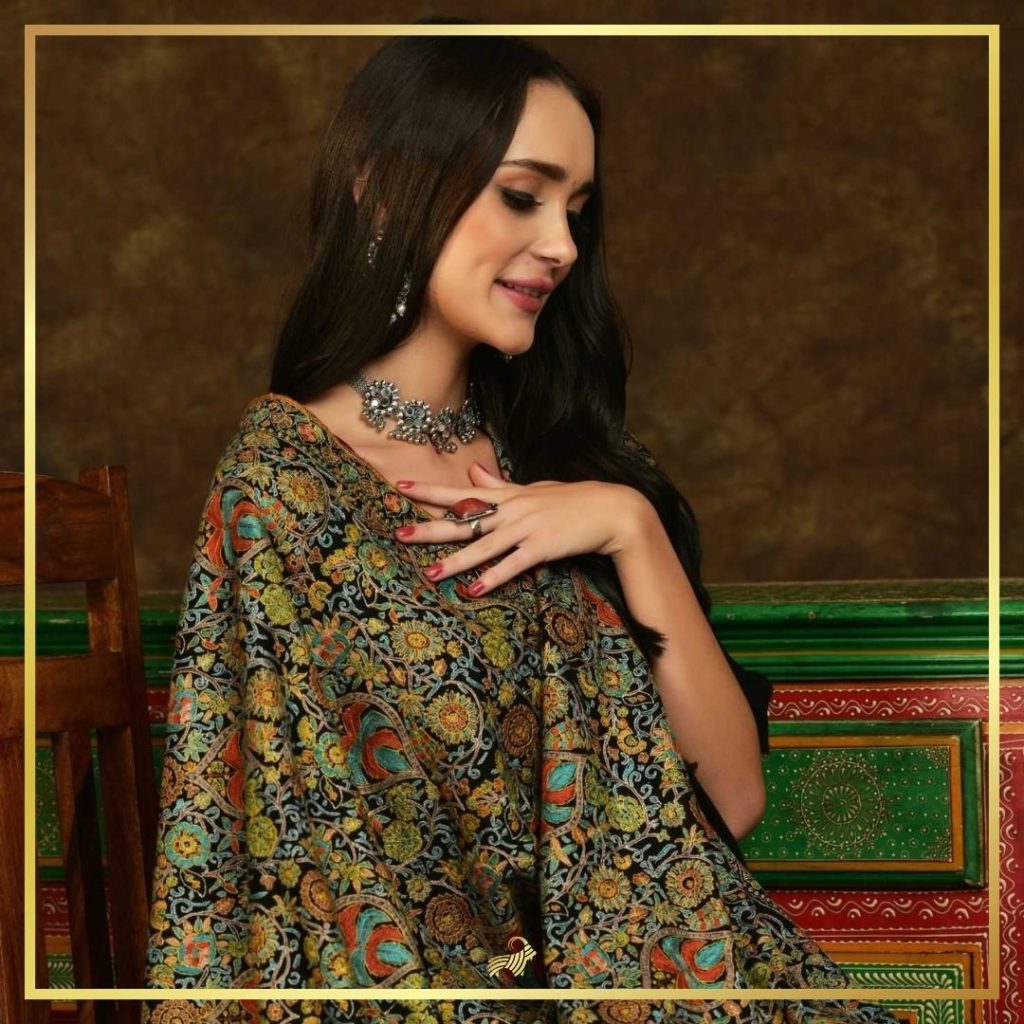When Pashmina spread its wings all across the globe, it was the Jamawar shawls that were considered the most premium. Exquisite was considered as an understatement for these Jamawar shawls, which were so laden with embroidery that the base was hardly visible. These were usually Sozni embroidered shawls which were also popular as Sozni shawls.
The Underlying Pashmina base
Pashmina is the fine art of handcrafting luxury shawls, scarves, and wraps from fine Cashmere wool. Cashmere is the undercoat of a Ladakhi goat, which was discovered in the 15th century by a Persian traveller. The traveller was the Sufi saint Shah E Hamdan, the same religious scholar, who brought all kinds of handicrafts to Kashmir from Persia. He discovered Cashmere in Ladakh and ordered socks to be made out of it. The socks were so soft, warm, and luxurious that the king ordered processing units of Cashmere to be set up in Kashmir.

Soon Cashmere wool was largely processed in Kashmir in huge quantities, and thousands of plain shawls were manufactured. But after some time, plain shawls were embellished with embroidery patterns, which too were taught by the Persian trainers to the locals. Since Pashmina shawls were lightweight and delicate, a more delicate form of embroidery thread had to be chosen to embroider it. Hence, sozni embroidery was chosen as the first of its kind, since its thread was feathery, light, and fine.
Sozni embroidery Artisans
The craftsmen of Sozni embroidery are men and women from the villages of Kashmir valley who were mostly farmers. Since Kashmir has always been an agriculturally rich place, most of the people in the villages are involved in fruit, vegetable, cereal, and animal farming. But farming is not a 365-day activity, as farms are full of snow in winters. Hence, the farmers turn into sozni embroidery artisans in winters and embroider shawls, stoles, apparel, and other fabrics.
Nevertheless, it should never be believed that since these artisans are farmers, they might not do justice with embroidery. The farmers are utmostly skilled and experienced embroidery artisans and hand-make such designs which are difficult to follow even for the eyes.
What is Sozni?

Sozni is a specialized and one of the most sophisticated forms of hand embroidery in the world. This exceptionally fine, delicate, and artistic form of needlework is only practiced in Kashmir and has no comparison anywhere in the world.
Steps of making a Sozni shawl
Sozni embroidery on a shawl is done in a number of steps. Here is the detail of each one of them.
Preparing the design
A design is prepared by the designer (locally called Naqash), which is to be embroidered on the shawl. The designer draws it on graph paper using geometrical techniques.
Carving a wooden block for Stamping
On the basis of the design that is made by the designer, a local walnut wooden block shop is visited to choose from a large variety of wooden stamps. If the design is new, a fresh block of wood is carved as per the design, which doesn't happen too often.
The blocks which have been carved decades ago are still used for stamping as motifs hardly change. Different blocks are used for the borders and different for the centre.
Stamping the sozni shawl
The wooden block used for stamping is dipped in chemical ink, and the shawl is stamped with a design carefully by a master craftsman. Printing is done carefully so that just an imprint remains for embroidery. Stamping the shawl should be done by the steady hands of experienced craftsmen and Kashmiri artisans are no less than perfectionists in this process.
The stamped shawl is passed on to a master artisan, who approves of it, and chooses the colours to be used for embroidery.
Embroidering the shawl
Sozni embroidery is considered a symbol of an artist’s perseverance, dedication, and skill. To embroider a Pashmina shawl in sozni, single-needle and thread are needed so that it becomes lightweight and fine. The embroidery requires massive hard work and concentration of the master embroidery artist. It is pure passion, and artisans claim that the time when they do Sozni work is their best time of the day!
The process of embroidery starts. Threads are chosen in silk and the base is Pashmina. The motifs usually are flowers, creepers, paisleys, and chinar leaves. Embroidered Pashmina shawls vary from each other as far as the density of embroidery is concerned. Thick all-over patterns are called Sozni Jamawar shawls, while those with loosely embroidered motifs are called Sozni Jaalidaar. The stitch can be open chain, couching, buttonhole, or the famous herringbone stitch locally called Kashmiri stitch.
Sozni Shawls - a heritage in itself

The confluence of Pashmina shawls and sozni embroidery is timeless. Their relevance has only grown with time. Sozni embroidery is classic and that is what makes a Sozni Pashmina shawl the regal accessory that it is. It takes each shawl a few months to complete and sometimes five or six years, based on the embroidery density. The deliberately slow pace and the utmost precision of the craftsman ensure excellence as well as perfection.
Even though, embroidery artisans must sit with their workpieces for a period of 6-8 hours every day, yet they love their work the most. Usually, artisans work from a usual 9-6 on a daily basis, with proper breaks. In this time, they can even fit 500 stitches per square centimeter of the shawl.
The process of making a Sozni embroidered Pashmina is a conscientious one. Sometimes the embroidery patterns are so dense that the Pashmina base is barely visible, and such shawls take 5 years to complete. In this process, sometimes a colour chosen for embroidery does not produce the desired effect. This stitch is undone and redone. Yet the artisans never get disinterested and work with as much vigor as they have on the very first day.
Post Embroidery
After a shawl is complete after the hard work of artisans, it is sent for washing. Since the shawl has already taken a few years to complete, it is necessary to wash it. The final washing of the shawl is done in Spring waters. Mild detergents are used, and the shawl is struck again and again against a smooth stone. Note that the washer of Pashmina shawls is different from the rest of the washers in the valley. It is a professional and labour intensive process that needs free-flowing water and many tough hands to manage. Later the shawls are dried in open grounds. There are no indoor spaces for drying Pashmina shawls.
Now the shawl is complete. It is given a number of finishing touches like cutting fringes, removal of any foreign material, etc. Now the shawl is ironed and packed to be sold out in the markets.
Workshops and factories of Sozni shawls
Sozni Kari is usually done by a group of men and women in home-based workshops. Some shawls are given to artisans to work on them from their respective homes. For large setups, men and women have to gather at a karkhana (factory) and work together in groups. This is a casual group, and random conversations take place between the members while having tea and lunch together.
A mere photograph does absolutely no justice to a perfectly crafted Pashmina shawl. One has to see it closely, feel it with bare hands, glare at their labyrinthine patterns, and then realise what treasure these are. Safe to say - a shawl is nothing less than a heritage in the making.
Also read: Pashmina - Creation beyond existence